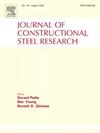Distribution characteristics of fire temperature field under I-type composite beam bridge
IF 4
2区 工程技术
Q1 CONSTRUCTION & BUILDING TECHNOLOGY
引用次数: 0
Abstract
In recent years, the I-type composite beam bridge has been adopted for green and low-carbon benefits. However, a fire beneath the bridge can expose steel girders to elevated temperatures, potentially leading the bridge to collapse. The complex spatial structure, consisting of main girders, transverse beams, and small longitudinal girders, influences fire smoke spread and temperature field. This research focused on the distribution of the fire temperature field. First, a detailed fire dynamics model was established and verified by similar tests. Then, parameters such as vehicle types, ambient winds, and vertical clearances were analyzed. Finally, a prediction formula was established. Results indicate that the fire temperature field is mainly influenced by smoke spread. The temperature is highest at the direct flame site, followed by bottom temperature of the bridge deck. It decreases as smoke spreads. The temperature at the bottom of the bridge deck is nearly uniform across each cross-bridge region divided by the main girders and small longitudinal girders. It decreases exponentially along the longitudinal direction as the distance from the fire source increases. Larger vehicle fires, lower wind speeds, and smaller vertical clearance lead to higher temperature. The bottom flange temperature of the exposed main girder reaches 1200 °C. Meanwhile, the bottom temperature of the bridge deck reaches 1000 °C. When the wind speed reaches 3 m/s or the vertical clearance reaches 22.5 m, the main girder and bridge deck temperatures are below 300 °C. A prediction formula considering these factors agrees well with the simulation results is proposed.

求助全文
约1分钟内获得全文
求助全文
来源期刊

Journal of Constructional Steel Research
工程技术-工程:土木
CiteScore
7.90
自引率
19.50%
发文量
550
审稿时长
46 days
期刊介绍:
The Journal of Constructional Steel Research provides an international forum for the presentation and discussion of the latest developments in structural steel research and their applications. It is aimed not only at researchers but also at those likely to be most affected by research results, i.e. designers and fabricators. Original papers of a high standard dealing with all aspects of steel research including theoretical and experimental research on elements, assemblages, connection and material properties are considered for publication.
 求助内容:
求助内容: 应助结果提醒方式:
应助结果提醒方式:


